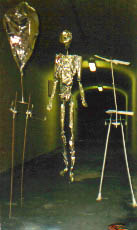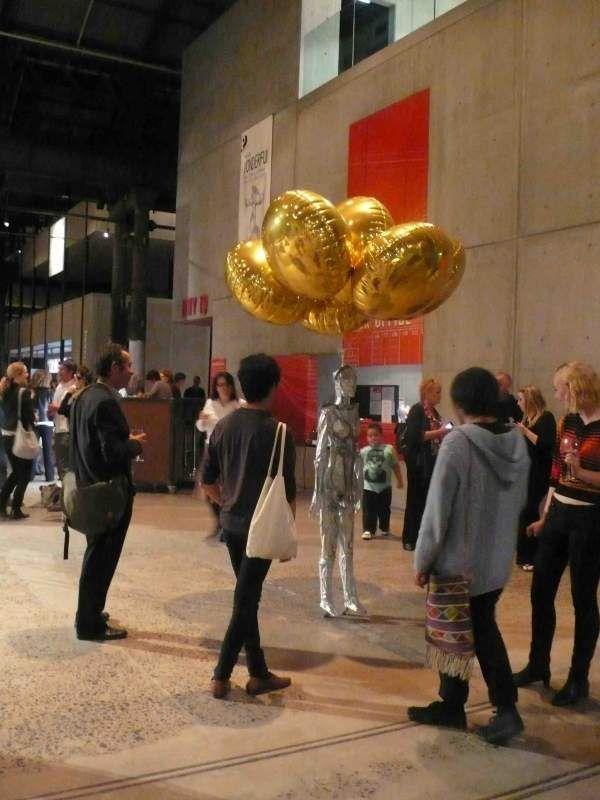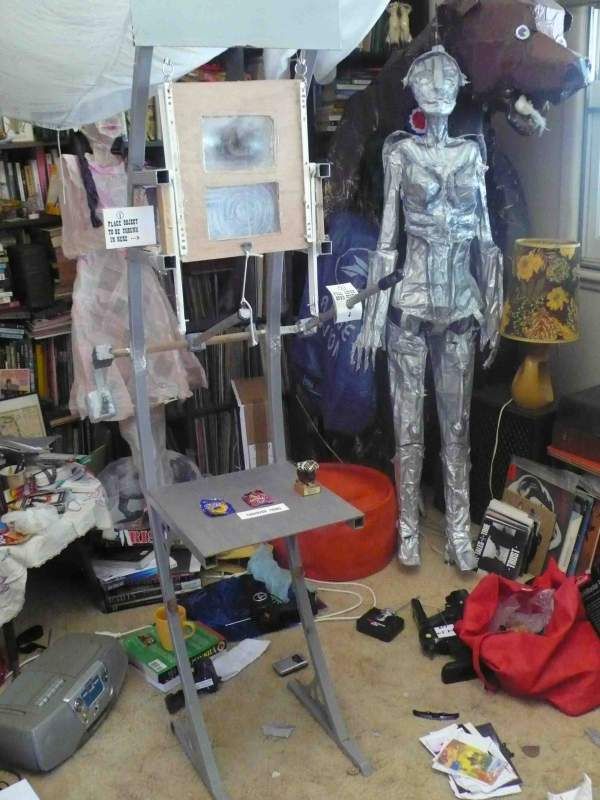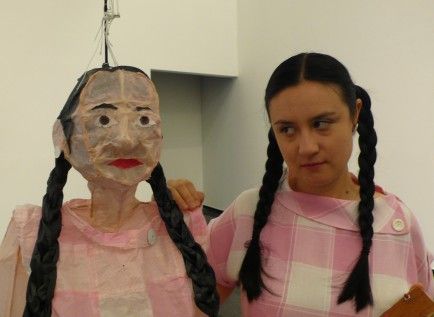
Life-size Humanoid Walking Robots
One of the hardest things to do in robotics is build a 2-legged robot. These robots, made from balsa wood and paper, use the lifting power provided by helium balloons or propellors to leverage themselved upright and activated via remote control. They seem to wander about with a mind of their own. One robot, the 'Hurricane robot' is made out of metal, its feet are heavy so it will stay upright. Its counter rotating propellors provide both lift and power to drive its legs. It might walk only a few steps a year, but last for thousands of years.
Simon Yates's mixed media, low-tech, backyard robots also display various aspects of himself. "A walking humanoid robots costs millions of dollars and they have taken 20 years to develop; mine cost $60 and took two weeks to make," Yates says. "I've been working on them for a few years and they've gradually been getting more advanced."
In Penrith he's showing The Robot That Looked Like Me, comprising seven large robots that show him at work, at play or wearing his favourite clothes. The robots are constructed from mechanical parts and fabrics available at a local shopping centre; helium balloons hold them in a standing position. They are "past, present, future or parallel universe versions of me", Yates says.
"The thing about them is that they are operated by remote control. It surprises people who try to manipulate them that they all move together because they all have the same frequency."
Yates is interested in the way men negotiate the many role and life choices they have: "It's a split personality thing. And there is also the sense of wanting to live in the moment, the present moment, and having so many parts of yourself in different areas," he says. "My idea about this show is that it's not any kind of celebration of masculinity.
"I think masculinity is something that needs to be explored and understood better because there's a lot of problems … It's too much of a generalisation to say man is to blame for wars or pollution, but those are in some ways the consequences of violence and other issues. But I don't know if that's wrong to say that."
Source: Reality check is in the male by Rosalie Higson, The Australian April 21, 2008.




Simon Yates – Artist statement
The sleek, metallic female robot from Fritz Lang’s 1926 film Metropolis is a contrast to the clanking, ungainly metal man, or the ‘pepper-pot’ robots seen in early science fiction films. Futura is sexy and dangerous. Looking at her, we can almost imagine her cold, calculating intelligence. In bringing Futura to life I hope to invoke this timeless, chilling symbol of technology as dangerous inscrutable, lacking soul or conscience, and ultimately as a sublime otherness, beyond our comprehension.
The Shrinking Ray – a magical box in which objects are made smaller – acts as a metaphor. It is a contemplative focus for thinking about current issues in our perception of technology. When Apple advertised a second generation of the iPhone as smaller than the previous one, it appeared that Apple had deceptively used an oversized hand in the advertisements. This made the iPhone appear smaller than it actually was.
There is a desire for technological objects to become smaller, taking up less time and less space, shrinking in all dimensions. At the same time, information and communication itself has become increasingly problematic, as we are inundated with more and more data. We have difficulty coping with the deluge. Psychologists are referred to as a ‘head-shrinkers’ because they unravel and shrink the patient’s problems. This is a different kind of process, one that is not so much about transmitting or receiving information with smaller devices, but about reorganising it, so it is easier to understand.
Simon Yates has made robot alter-egos, invisibility devices and magical bicycles where mice run inside the wheels. A gentleman scientist and inventor, he has the ability to transform everyday things into miraculous, perception-shifting objects. Working on a shoestring budget, Yates has set out to prove that all you need to improve the world is cardboard, tissue paper, and things other people have dumped on the side of the road (with a pinch of genius to stick it all together).

"Rhabdomancy" by Simon Yates (2009) is life sized walking robots of himself and the writer Vanessa Berry. This video was made at ACCA, as the robots guarded the foyer during the exhibition NEW 09. Remote controlled, and holding divining rods, the robots wander around the gallery, sensing what humans cannot.

Vanessa Berry with robot of herself.
A very early fictional robot based on a similar idea – see here.
.jpg)
See other Pneumatic, Fluidic, and Inflatable robots here.